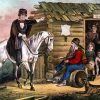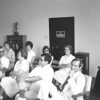calsfoundation@cals.org
Soto Voce
2025 April Fools’ Day Entry
Soto Voce is an early draft musical written by composer Andrew Lloyd Webber in the 1960s about the expedition of Spanish explorer Hernando de Soto across the southeastern United States, including scenes set in Arkansas. Lloyd Webber never arranged for the musical to be performed, feeling it was ultimately not worthy of production, but he later adapted some of the musical numbers for later works, such as Jesus Christ Superstar, which debuted in 1971, and Cats, which debuted ten years later.
Andrew Lloyd Webber (born in 1948 in London) is easily the most recognized talent in the field of musical theater in the world, with twenty-one musicals to his name, a number of which debuted on Broadway and have contributed to what is called the “megamusical” phenomenon—or the growing prevalence of blockbusters and highly profitable touring shows, previously unknown to musical theater. A number of Lloyd Webber’s works have also been adapted into major studio films, such as Les Misérables (2012) and Cats (2019).
Dating the composition of Soto Voce to a particular year is challenging, given that Lloyd Webber has refused to talk publicly about the early manuscript, which surfaced only in 1993, when Alan Doggett, a family friend of Lloyd Webber, mentioned the draft musical in an April 1, 1993, interview with the British newspaper the Independent. Doggett mentioned in this interview having just returned from a recent trip to the United States, where he encountered Joyce Rockwood Hudson’s new book, Looking for De Soto: A Search through the South for the Spaniard’s Trail, and how the book had brought back memories of this earlier work, on which he had provided some crucial feedback. Soto Voce was written in 1966 or 1967, not long after The Likes of Us, a musical on which Lloyd-Webber had collaborated with songwriter Tim Rice, which was shelved and not actually performed until much later. Doggett later provided a mimeographed copy of Soto Voce to the Independent, much to the consternation of Lloyd Webber, who, at the time, was experiencing a financial setback with his theatrical adaptation of Sunset Boulevard, although The Phantom of the Opera, which had debuted in 1986, was still going strong at both the West End in London and on Broadway in New York.
To date, Lloyd Webber’s only public comment on Soto Voce has been to relegate it to a bit of “juvenilia,” and he has permitted no public performances of the work. Why he initially selected the subject of Hernando de Soto’s expedition for a musical remains unknown to any but himself.
The title Soto Voce is a pun on the Latin term sotto voce, which means “under the voice,” or the practice of lowering one’s voice for dramatic effect. In fact, the title only works as a pun; some have assumed that Lloyd Webber meant the title to be translated as “Soto’s Voice,” but an accurate translation of that phrase into Latin would be Soto Vox. As historian Michael B. Dougan has written, “This is what happens when you ditch your studies at Oxford University to go hang out listening to the Rolling Stones. Those infamous copyists no doubt influenced L. W.’s own career as a shameless plagiarius of cheap tunes and cheaper words.”
The narrative of Soto Voce follows in general the history of the de Soto expedition from its landing on the southwestern coast of Florida, his travels through what is now the southeastern United States, his crossing of the Mississippi River, and his travels through Arkansas and eventual death in what is now Chicot County. Most scholars who have compared the plot of Soto Voce to the published accounts of the expedition agree that Lloyd Webber likely based much of his storyline on the later chronicle by Garcilaso de la Vega, written decades after the expedition, with many fictional episodes added.
Musical theater aficionados are primarily interested in Soto Voce for the says in which the musical served as a workshop for Lloyd Webber’s later songs. Lloyd Webber has a long history of reusing his own material. For example, he and Tim Rice wrote a song titled “Try It and See” for the 1969 Eurovision Song Contest, and after the song was not selected, they rewrote the lyrics, keeping the tune, to make it “King Herod’s Song” in Jesus Christ Superstar. In like manner, many of the tunes from the unperformed Soto Voce were later reworked for more successful musicals. For example, the Indian chief Casqui’s song, “I Don’t Know How to Love Him,” sung about his ongoing feud with rival chief Pacaha, was later changed and used in Jesus Christ Superstar, being sung in that instance by Mary Magdalene about Jesus.
Probably the most famous of Lloyd Webber’s songs, “Memory” from the musical Cats, also has its origins in Soto Voce. In the latter play, the song is sung by de Soto on the evening after he and his men enter through the town of Quizquiz on May 8, 1541, while all the men are away working in the cornfields, leaving the women undefended. The chronicles record that de Soto and his men captured some 300 women by force, but in Soto Voce, the women continue their daily routine well into evening, untroubled by these foreign visitors, while topless, completely ignorant of the European custom of sartorial modesty. That evening, as de Soto watches the women return to their homes, he reflects upon the ridiculousness of European customs and how they separate humanity from nature, singing:
Mam’ries, all exposed in the moonlight
I can smile at our old ways
We were so prudish then
I remember the time I knew what modesty was
Let the mam’ries be seen again
Another of Lloyd Webber’s most famous tunes also originates from this musical. When de Soto and his army cross the Arkansas River and advance toward Guachoya, a palisaded community scholars now believe was located in Desha County, the people of Guachoya flee from the town, carrying their possessions with them. From the top of the mound in the center of the community, de Soto sings out to the people running away from him:
Don’t flee from me, Guachoya
The truth is I dearly need you
All through my wild days
My mad existence
I kept my promise, don’t keep your distance
With very slight alteration, the song was adapted for the 1976 concept album Evita, itself later adapted into a musical and film.
Little Rock (Pulaski County) boosters pitched the renovation of the Robinson Center Music Hall, which took place from 2014 to 2016, as necessary to attract such touring shows as many of the works of Lloyd Webber, and while the city was successful in recruiting a touring production of The Phantom of the Opera to the city, local leaders were unsuccessful in their behind-the-scenes efforts to negotiate the first ever public performance of Soto Voce—the only musical by the legendary figure to have any Arkansas connection.
Soto Voce has never been performed, and until the work enters public domain, the chances that it will ever be performed remain miniscule.
For additional information:
Dougan, Michael B. “The Music of the Blight: Ahistorical Representations of a Spanish Expedition in Soto Voce.” Arkansas Historical Quarterly 82 (Autumn 2023): 227–245.
Martin, Philip. “School of Schlock.” Arkansas Democrat-Gazette, December 28, 2024, pp. 1H, 6H.
Peacock, Leslie Newell. “Love Never Dies, but Dreams Do.” Arkansas Times, January 2017, pp. 27–35.
Gaston Leroux
Opera in the Ozarks
APRIL FOOLS!
 Arts, Culture, and Entertainment
Arts, Culture, and Entertainment Divergent Prosperity and the Arc of Reform, 1968–2022
Divergent Prosperity and the Arc of Reform, 1968–2022 Soto Voce Poster
Soto Voce Poster 



Comments
No comments on this entry yet.